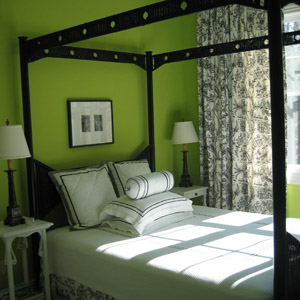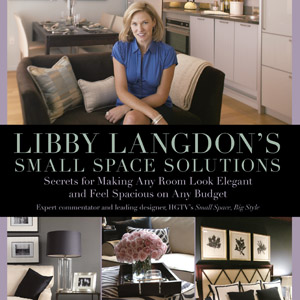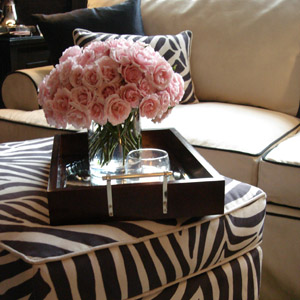 |

The best approach to cutting back on clutter is to work on one room at a time. Photo courtesy of Libby Langdon Interior Design

Libby Langdon, design expert on HGTV’s Small Space, Big Style and author of Libby Langdon’s Small Space Solutions, offers simple tricks for making the most of your small spaces. Photo courtesy of Libby Langdon Interior Design

A clutter-free home is a beautiful home. Photo courtesy of Libby Langdon Interior Design
A clutter-free home is a beautiful home. Photo courtesy of Libby Langdon Interior Design
Cutting Clutter Is Essential to Any Design Project
“Style, elegance and comfort begin in a clean organized space,” says Libby Langdon, design expert on HGTV’s Small Space, Big Style and author of Libby Langdon’s Small Space Solutions. “Getting rid of clutter is the first thing we do on makeover TV,” she says. “Before I begin any makeover or redesign of a space, I make sure my client throws away unnecessary items before we get started.”
-
Libby Langdon’s Advice for Creating a Clutter-Free Castle
Libby Langdon, design expert on HGTV’s 'Small Space, Big Style' and author of 'Libby Langdon’s Small Space Solutions' shows how you can cut clutter for a happier, more beautiful home.
- by Jennifer Sellers
You can have a home expertly designed by a top interior designer. It can be filled with fine furniture, accessories from across the globe and one-of-a-kind art. But if your home is covered with clutter, none of that matters. Its beauty is diminished, and so is the joy you feel when you’re there. So honor your home’s décor—whether it is grand or humble—by getting rid of clutter for good.
Interior designer Libby Langdon is an expert clutter cutter. She has been giving advice on streamlining spaces to clients and TV viewers alike, and here she shares her favorite tips.
Develop a Clutter-Free Mindset
We’d all like to live with less clutter, but because of the emotional attachments most of us have toward our “stuff,” getting rid of it can be a challenge. That’s why the first step to de-cluttering is to mentally prepare for it. “Clutter takes up mental and physical space,” says Langdon. “To get in the mindset of de-cluttering ask yourself: ‘If I had 20 minutes to evacuate my home, what would I take?’ Or, pretend you’re moving and ask yourself what you wouldn’t want to move.”
Another tip, says Langdon, is to rate your de-cluttering goal. “Think about how much stuff you have,” she says. “On a scale of 0-10, with 10 being everything you own now and 0 being nothing, what number would you prefer to represent your things? If your number is, say, 5. Your goal should be to eliminate half your belongings.”
Understand What De-cluttering Is
Clearing out your clutter may seem like a natural part of housekeeping, but it’s much more than that, says Langdon. “Getting rid of clutter isn’t about cleaning, it’s about overcoming obstacles. Clutter can keep you from mentally moving forward. A good de-cluttering session can encourage you to look at your home in an entirely new way.”
Define Your Clutter
To properly eliminate clutter, you need to establish what kind you have. “Clutter comes in different forms: It can be items in the wrong place or things you don’t need,” says Langdon. “It can be unfinished objects left out or belongings you haven’t made decisions about yet.”
Target a Room
The best approach to cutting back on clutter is to work on one room at a time. Langdon suggests starting with your messiest room first. “Decide which room poses the biggest dilemma, and begin there—whether it’s your closet, pantry home office or bathroom,” she says. “This will keep you focused and help you see progress in a shorter amount of time. De-cluttering your life is a powerful experience, and it is also contagious. You’ll want to keep going.”
Give Yourself Time
De-cluttering doesn’t happen overnight. After all, you’ve probably been accumulating your stuff for years. “You need to simplify and get back to basics,” says Langdon. “It doesn’t happen all at one time; it’s a process. It occurs little by little. Before you know it, you’re coming out from under all that stuff that’s been crowding your home and mind. Remember, organizing is a process, not a one-time event.”
To keep from getting overwhelmed by the amount of clutter that awaits you, Langdon suggests doing a little at a time—and timing yourself. “When you start de-cluttering, set a timer for 30 minutes,” she says. “Give yourself permission to stop when the time is up, but keep going if you feel inspired.”
Decide What Stays and What Goes
For many of us, this is the hardest part of de-cluttering. Langdon offers an easy solution to this problem: “Save pictures, not objects,” she says. “Take a picture of your son in his scout uniform. Keep the photo and get rid of the uniform. It’s the memory you’re trying to hold onto, not the uniform.”
Get Your Clutter out of the House
As you go through your things, Langdon recommends sorting what you don’t want into two categories: donate and pitch. But she warns not to let either pile remain in your house for long: “Don’t allow yourself to go back into the donate bags. Get the bags out of your house ASAP. Trash the pitch bags and take the donate bags to the Salvation Army.”
Give Your Things a Home
The things you decide to keep should all have specific keeping places. “Find a home for remaining items,” says Langdon. “Be diligent about putting things back in their home. Avoid the trap of leaving something out to remember it later.”
And as you find places to store and display your things, remember that you should also leave empty spaces in your home. “Everything should have a space, but not every space should have a thing,” says Langdon. “Leave some open space on shelves and countertops Focus knick-knacks and collections in one area instead of all over.”
Keep One Defined Place for Clutter
Your goal may be to eliminate all junk from your home, but having a small clutter catch-all will actually help protect your house from another clutter takeover. “Create an emergency clutter holder in a high-traffic area like the kitchen or entry to keep mail and small essentials from cluttering countertops,” says Langdon. “Empty it regularly.”
Seek Efficient and Aesthetic Storage Solutions
When it comes to storing your stuff, Langdon offers these strategies: 1) making the most of your space, and 2) creating a clean look. “Measure boxes and hang shelves at those exact heights,” she says. “You don’t want to waste an inch of space. And chic storage boxes consistent in color and fabric will create an organized look.”
Maintain a Clutter-Free Lifestyle
Keeping your home clutter-free can be a challenge. You may find it easy to go back to the habits that built up clutter in the first place. To stop stuff-collecting in its tracks, you need to live by the “in-and-out” rule, says Langdon. “For every item you bring in your home, you need to toss, recycle or give away one item. If you receive two new sweaters for your birthday, get rid of two old sweaters.”
With Langdon’s tips, your home will be a clutter-free zone in no time, and you can experience the happiness a simpler, more-organized abode brings. As she likes to say, “living with less doesn’t mean living without luxury. Living with less ‘stuff’ is the ultimate luxury.”

